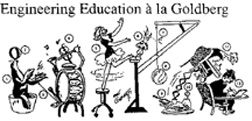 Purdue News
Purdue News
 Purdue News
Purdue News
March 14, 1997
But that's what college students are building -- on purpose! -- for the ninth annual National Rube Goldberg Machine Contest at 11:30 a.m. April 5 in Purdue's Elliott Hall of Music.

|
The contest is free and open to the public.
Students build their machines by combining the principles of physics and engineering with common objects, such as marbles, mouse traps, bicycle parts, stuffed animals, bowling balls, electric fans, rubber tubing, small kitchen appliances and lots of duct tape.
Goldberg was a cartoonist who specialized in drawing whimsical machines with complex mechanisms to perform simple tasks.
Machines will be judged on the creative use of materials and use of related themes. Each machine must run, be reset and run again in nine minutes. Points are taken off for human intervention after the machine starts or for exceeding the time limit.
Purdue's team was chosen in February at a local contest. A group of four students representing the American Society of Mechanical Engineers won with a machine based on Americana. The 40-step contraption, which included a baseball mitt, a doll representing "mother," and a red, white and blue electric fan, concluded by playing Bruce Springsteen's "Born in the USA."
A Purdue team won the national competition last year. Teams signed up to challenge Purdue for the 1997 title are: Hofstra University, Hempstead, N.Y. ; Lawrence Technological University, Southfield, Mich. ; Mississippi State University, Mississippi State, Miss. ; the University of Texas-Austin ; the University of Toledo ; and the University of Wisconsin-Madison .
The winning team will receive a cash prize and the five-foot-tall traveling Rube Goldberg trophy. The second- and third-place teams also receive cash and trophies.
In addition, a "People's Choice" award will be given to the team whose machine gets the most votes from audience members.
The contest is organized by student members of the Purdue chapter of Theta Tau, a professional engineering fraternity, with support from Rube Goldberg Inc. The fraternity maintains a World Wide Web page at https://cernan.ecn.purdue.edu/~colpi//RUBE/Index.html
The contest at Purdue started in 1949 and ran until 1955. It was revived by Theta Tau in 1983 to celebrate National Engineers' Week. The first National Rube Goldberg Machine Contest was held at Purdue in 1989.
Past contests have attracted nationwide attention in magazines and newspapers and on TV. The contest also has received international television coverage from Australian-produced "Beyond 2000" and a Japanese science and technology program called "High-Tech Shower."
Source: Daniel Colpi, student contest chairman, (765) 743-8135; e-mail, colpi@cernan.ecn.purdue.edu
Writer: Amanda Siegfried, (765) 494-4709; e-mail, amanda_siegfried@purdue.edu
Purdue News Service: (765) 494-2096; e-mail, purduenews@purdue.edu
Photo caption
Download here.
NOTE TO JOURNALISTS: Video and photographs of past contests are available. An ISDN line is available for radio interviews. Journalists will not be allowed on the stage during the competition, but they are welcome on stage before and after the contest. Purdue will provide video and photo pool coverage and direct audio and video feeds. Video b-roll, photos and a news release will be available the afternoon of the event. Satellite assistance is available. For more information, contact Amanda Siegfried, News Service, (765) 494-4709; e-mail, amanda_siegfried@purdue.edu